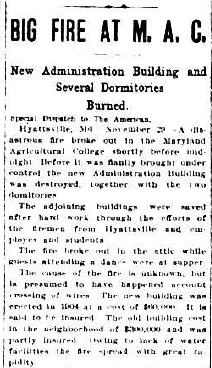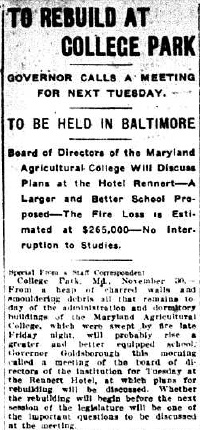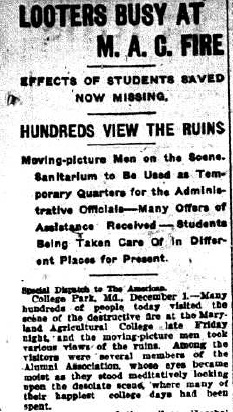Local Press
The Baltimore American
Click a thumbnail image to read the full transcript of each article.
BIG FIRE AT M. A. C.
New Administration Building and Several Dormitories Burned
Special Dispatch to the American
Hyattsville, Md., November 29 — A disastrous fire broke out in the Maryland Agricultural College shortly before mid-night. Before it was finally brought under control, the new Administration Building was destroyed, together with the two dormitories.
The adjoining buildings were saved after hard work through the efforts of the firemen from Hyattsville and employees and students.
The fire broke out in the attic while guests attending a dance were at supper.
The cause of the fire is unknown, but is presumed to have happened account crossing of wires. The new building was erected in 1904 at a cost of $60,000. It is said to be insured. The old building cost in the neighborhood of $300,000 and was partly insured. Owing to lack of water facilities, the fire spread with great rapidity.
The new administration building housed about 185 students, all of whom got out safely, and the old building contained about an equal number of cadets. Possibly all of the records of the college were gotten out of the building. The building contained the president's office, the treasurer's office and the board of trustees' office, besides the assembly hall.
Owing to the fact that it is the holiday season, many of the cadets were away and their property was destroyed. The total loss is estimated by officials of the college at $150,000, covered by insurance. Two fire companies from Washington arrived after midnight, but the buildings were too far gone for them to be of any service. They came out on Baltimore and Ohio trucks. The campus in front of the destroyed building is filled with furniture, etc., removed from the burning building and a large crowd from the surrounding country is watching the flames.
Temporary quarters for the students will be provided in Science Hall and other buildings.
TO REBUILD AT COLLEGE PARK
Governor Calls A Meeting For Next Tuesday.
TO BE HELD IN BALTIMORE
Board of Directors of the Maryland Agricultural College Will Discuss Plans at the Hotel Rennert—A Larger and Better School Proposed—The Fire Loss is Estimated at $265,000—No Interruption to Studies
Special From a Staff Correspondent
College Park, Md., November 30 — From a heap of charred walls and smouldering debris, all that remains today of the administration and dormitory buildings of the Maryland Agricultural College, which were swept by fire late Friday night, will probably rise a greater and better equipped school. Governor Goldsborough this morning called a meeting of the board of directors of the institution for Tuesday at the Rennert Hotel, at which plans for rebuilding will be discussed. Whether the rebuilding will begin before the next session of the legislature will be one of the important questions to be discussed at the meeting.
Little remains of the two buildings, the most important of the school. The administration building and the structure familiarly referred to as the "Old Barracks" are no more than a ruined heap of granite and bricks. The fire fanned by a brisk wind from the southwest, started at 10:30 o'clock Friday night, and swept and completely wrecked the two buildings. Officials for the institution estimate the loss at $265,000, including the loss suffered by the student body. Both burned buildings were insured.
Studies to Go On.
According to R. W. Sylvester, president of the college, there will be no interruption to studies, which, he said, will be resumed Wednesday at noon in the 14 remaining lecture rooms in Science Hall and other outbuildings. Some of the students are being accommodated by families in the vicinity of the college, Hyattsville, and Berwyn.
This morning C. H. Stanley, chairman of the executive committee of the college, and John Hubert, president of the First Branch City Council, of Baltimore, who is chairman of the building committee, visited the scene, and gave orders that the studies be resumed Wednesday. This advice was also given by Governor Goldsborough, who announced over the long-distance telephone that he would call the meeting Tuesday.
Perhaps the worst hit is the student body itself. The buildings were well insured by the state, the money from which will probably be used to erect a modern building of 500 rooms or more to replace those which were destroyed. Of the 265 students attending the college, all but 40 were at their home enjoying the Thanksgiving vacation, which began last Wednesday. Those who were away lost practically all the belongings they had in the college.
The 40 pupils who were at the college Friday night were enjoying a dance, their fair companies being young women of the neighboring towns and Washington. At the time the fire was discovered the young folks had enjoyed 10 sets and were seated at the dinner table.
Dancers to the Rescue.
W. C. Stanton, of Grantsville, Md., who discovered the fire between the second and third floors of the old barracks, directly over the room of W. E. Howe and L.C. Wilson, quietly informed several of his friends in the dining-hall of the fire. The young men in turn spoke quietly to the young women and there was not the least sign of a panic. The women were asked to vacate the building as hurriedly as possible while the men fought the fire.
A number of streams from small pipe lines leading from the 25,000-gallon tank in the rear of both buildings were turned on the blaze, but the fire spread rapidly. Realizing that their personal effects would be destroyed, a number of the young men bent their efforts to saving trunks, suitcases and other movable valuables. Only a small number of trunks were saved, and these were scattered about the lawn today, many unclaimed and unrecognizable.
Many of the young women coolly joined in the work of saving property and also lent their aid in dragging the few lines of hose. Many beautiful dresses were torn, soaked with water and ruined, but despite this the girls fought bravely and accomplished much.
Unmindful of the fact that they were taking chances of contracting colds, the young women worked until morning, after two of them had succeeded, with the help of students, in getting two of those who were still in the dormitories out from the stifling fumes.
Realizing that the small streams of water poured on the fire by the students themselves were of no avail, a call for help was sent to Hyattsville, and in a short time 20 members of the Hyattsville Volunteer Fire Company were on hand and did everything in their power to avert the destruction of the building. Water facilities were bad. Just after the arrival of the Hyattsville people the supply of water from the tank in the rear gave out.
Two engine companies were sent to the college grounds on a special train from Washington.
When the blaze was at its height, there was, according to the students, a mysterious spluttering throughout the fire, followed by a shower of bricks and granite, some of the pieces falling 200 yards away from the building. Captain Sylvester said that he could not account for the origin of the fire unless it started from defective wiring. A number of the younger students, who were not attending the dance, ventured the information this morning that they had seen several flashes of light in the southwest wing shortly before the alarm of fire was given.
The Burned Buildings.
The administration building was erected under an act of the Maryland legislature, and cost approximately $75,000, including equipment and furniture. In this building were the offices of the president and other members of the faculty, and those of the secretary and treasurer. The meeting-room of the board of directors also occupied part of the first floor, as did the dance hall and recreation halls. The upper floor formed an adjunct to the dormitories in the old barracks. Most of the valuable records and papers of the institution were saved from the rooms on the first floor, as well as several articles of treasured fixings and furniture.
The barracks, or the main and oldest building in the college group, was erected in 1854 on property donated by the late Charles B. Calvert. The building was erected by private subscriptions from leading citizens of the state, who were interested in the establishment of an institution for the dissemination of agricultural knowledge among the young men of the state. Later, the State of Maryland became a part owner of the college and its grounds, and at every session of the legislature an amount is appropriated for the maintenance of the college. This amount is usually $9,000. The second and third floors of this building were devoted to the sleeping quarters of the students. The first floor comprised a recreation hall and commandant's quarters, while the mess rooms and dining rooms of both faculty and student body were in the basement.
For More Water.
If, at the meeting of the directors next Tuesday, it is decided to begin the rebuilding at once, the faculty of the college will ask that a water-pressure system for emergencies be installed at the same time. With the erection of a new building the officials of the college are in hopes that a new gymnasium will also be fitted out. That the buildings will be erected on a more efficient scale is the hope and belief of all those interested in the institution, and the directors feel that the disaster presents an opportunity to equip the college anew with more modern apparatus and better living facilities.
Fourteen lecture-rooms in Science Hall, the machine shop and the geographical building remain, and it is in these that studies will be resumed Wednesday.
Many residents of the surrounding towns flocked to the college grounds today. A few prominent Washingtonians were there in the afternoon. Governor Goldsborough did not visit the scene. All advices were received and given by him over the long-distance telephone.
During the afternoon, when the greater part of the rescued property was removed to neighboring farmhouses, Captain Sylvester and Treasurer Ford stood by the heap of ruins looking ruefully at what had been their home for the past 20 years. After inspecting the debris and organizing several parties of hands to get things in as good order as possible, both Captain Sylvester and Mr. Ford retired to their temporary quarters in the laboratory of the machine building.
LOOTERS BUSY AT M.A.C. FIRE
Effects Of Students Saved Now Missing
HUNDREDS VIEW THE RUINS
Moving—Picture Men On The Scene. Sanitarium To Be Used As Temporary Quarters For The Administrative Officials—Many Offers Of Assistance Received—Students Being Taken Care Of In Different Places For Present.
Special dispatch to The American.
College Park, Md., December 1. — Many hundreds of people today visited the scene of the destructive fire at the Maryland Agricultural College late Friday night, and the moving-picture men took various views of the ruins. Among the visitors were several members of the Alumni Association, whose eyes became moist as they stood meditatively looking upon the desolate scene, where many of their happiest college days had been spent.
The treasurer of the college, Herchel Ford, returned late last night, and at once proceeded to arrange for temporary quarters for President Silvester and himself. For the present the sanitarium will be used for the administrative offices. The large safe, containing valuable records will be taken from the ruins Tuesday morning. It is believed that the contents are intact.
Many of the students returned from their Thanksgiving vacations last night, and today are being housed at the homes of the professors in College Park and vicinity. A large number of communications have been received from parents, all expression their intention of allowing the boys to return in time for the re–opening of the school Wednesday afternoon. A committee, composed of Profs. W.T.L. Taliaferro, F. B. Bomberger, H.T. Harrison, Ernest Coby, J.B.S. Norton, A.B. Gahan and H.S. Beckenstrater has been busy today locating the students in private houses in the neighborhood. About 50 of the students will be accommodated in Hyattsville.
Looters Take Effects.
A distressing result of the conflagration is the discovery that considerable looting took place during or immediately after the fire. Many of the absent students, who had reason to believe that their clothing and effects had been saved by the cadets at the college, returned to find that they had lost practically everything. In many instances the cadets declare that these effects were taken from the doomed buildings; but after the confusion attending the fire had subsided these goods could not be found. The officials at the college exonerate the cadets and state that the strangers attracted to the fire made away with the articles. These goods for the most part were taken from obscure parts of the premises not under patrol.
After getting what they could out of the rooms the cadets turned their attention to fighting the flames, and their work was highly commendable. The strange part of it is that, although imperiling their lives, some of the cadets were even slightly injured. It is highly probable that the college authorities will establish a few dormitories in buildings close to the college.
President R.W. Sylvester has received many letters of condolence from heads of prominent colleges all over the country and offers of assistance in the way of providing furniture, etc., have been received from Washington and Baltimore business houses. But two of the lecture–rooms out of the 19 were put out of commission, these being the department of languages and mathematics. Vice President Thomas H. Spence, professor of languages, will locate his lecture–room in the college museum, while Prof. H.T. Harrison will utilize one of the laboratories in the mechanical engineering department for his department of mathematics.
To Give Short Winter Course.
The officials announce that the students anticipating taking the short winter course beginning January 8 will not be disappointed, and this course will be pursued without interruption. A competent staff of lecturers on poultry, domestic science, agriculture and horticulture has been engaged and sessions will be held in the various lecture–rooms. A list of the prospective students for the short course, to whom it was intended to send a prospectus, has been lost, but it is expected that these will make known their wishes by writing the college.
Despite the fact that the Maryland Agricultural College has won more than its proportion of honors in literary contests, there never has been adequate facilities for the proper handling of this feature. It is known that the officials will provide for proper literary society halls in the new buildings. It is also the general impression that the main college buildings will not be erected on the site of the one burned. It is quite probable that, if proper quadrangular space can be provided, the large building will be erected on the campus immediately in front of the old buildings. It is the intention also to provide suitable quarters for the basketball team. This is about the only feature of athletics that has suffered at the college, and it has been due to the fact that the present gymnasium is not of the standard size to properly play the game. The athletic council intends to develop the basketball feature at the college.



